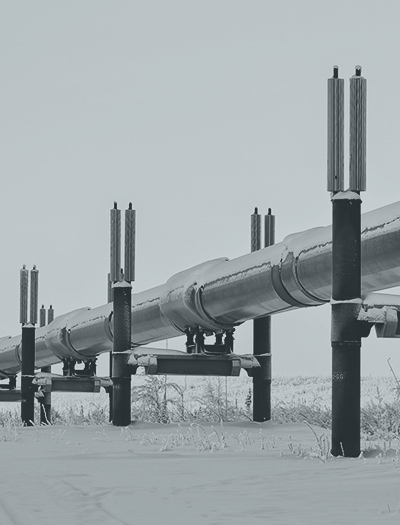Basic Theory of Metallic Corrosion
Corrosion is an electrochemical process in which four (4) conditions must be present or corrosion will not take place:
- There must be a positive or anodic area, referred to as the “anode”.
- There must be a negative or cathodic area, referred to as the “cathode”.
- There must be a moisture-bearing electrolyte for ionic current flow between the anode and cathode. It is important to note that the anode and cathode must be immersed in the same electrolyte. The atmosphere is not an electrolyte. Two pieces of metal touching each other in a humid environment develop excellent conditions where current flow will occur.
- There must be a return path for electronic current flow, which is referred to as a “metallic path” between the anode and cathode.
In a galvanic reaction, the electrical potential (voltage) difference between the anode and cathode causes the corrosion current to flow. The anode is the area that suffers metal loss or corrosion. This is the result of current discharging from the metal surface. The amount of metal that will corrode (rust) is directly proportional to the amount of current flow. For example, one ampere of direct current discharging into a soil or water electrolyte can remove approximately twenty (20) pounds of steel in one (1) year. In this example, the corrosion rate for steel is 20 pounds/amp-year. Each metal has its own, distinct corrosion rate and has the unit of measure of so many “pounds per amp-year”. In soil electrolytes, the actual amount of metal that corrodes in a year is measured in grams. The reason for this is that in soils, there is a very low current discharge. The current discharged is measured in the thousandths of an ampere, or milliamps (1000 mA = 1 Amp). Knowing a few facts, the estimated amount of current discharged can be easily calculated by using “Ohm´s Law”, which states that Voltage is equal to Amps multiplied times Resistance (E = IR). Consequently, one can easily understand that the amount of current that will discharge is inversely proportional to amount of resistance in the circuit. In non-mathematical terms, for a constant voltage difference between the anode and cathode, the amount of anode current increases as the circuit resistance decreases. Hence, the reverse is also true, in that the amount of anode current decreases as the circuit resistance increases. The amount of current that discharges into an electrolyte is then directly related to how much metal will corrode (rusts).
If one of the four conditions mentioned above could be eliminated, the corrosion process and/or metal loss can be prevented or mitigated. In most situations, this cannot be done economically; hence, a “Cathodic Protection” (CP) system is employed and is one of the most common methods of achieving corrosion mitigation in the corrosion engineering industry today. The CP system mitigates corrosion by eliminating all anodic areas on a metallic structure immersed in an electrolyte. It does this by making the structure a net receiver of current instead of being a discharger of current. It is similar to installing an electric shield (dam) around the structure and saying “you (the structure) cannot discharge current because you are a net receiver of current”. Remember, any metal that discharges current, corrodes; and any metal that receives current, is protected.
Cathodic Protection is usually accomplished through one of two methods: The first method involves connecting a galvanic anode to the structure to be protected, by using a metallic conductor such as an insulated copper wire. The anode in this case, is made from a metal that has a higher natural potential (voltage) than the structure´s natural potential. Magnesium is one of the more common galvanic anode materials used in land based CP systems, because of its high natural potential. This type of CP system relies completely on the difference in the “natural” galvanic potentials between the two metals to cause the cathodic protection current to flow; hence, the name “Galvanic CP System” was created. When two metals are immersed in the same electrolyte and there is a metallic path between them, the metal with the lower potential becomes cathodic to the other metal, which becomes anodic. The reason for this occurrence is that the two metals have a difference or an imbalance in potential, resulting in one being a net receiver of current and becomes cathodic (protected). The other metal, with the higher potential, becomes anodic because it is a net discharger of current and it corrodes (rusts) going into its oxide state. The greater the difference in potential between the two metals, the more the current will flow, when all other variables remain constant. Since the voltages associated with galvanic CP systems are relatively low, the small potential difference, which exists between two metals, results in a relative low current output (milliamps). This type of CP system is normally associated with very small and/or well-coated structures that are immersed in a conductive (low resistivity) electrolyte. The second common type of CP system is an Impressed Current System. This type of CP system relies on an external direct current source such as a rectifier, solar panel, battery, fuel cell, etc., to force current to flow to the structure to be protected. The current is forced or directed in a fixed path; however, this is determined by how the connections are made to the power source. Whatever is connected to the positive terminal of the power source will become the anode, and whatever is connected to the negative terminal becomes the cathode. Consequently, it is readily discernable how important it is to connect the structure to be protected to the negative terminal and not the positive terminal, which would make it the anode. Since this system incorporates an external power source, it can be sized to generate any voltage required to produce the appropriate current to protect the structure. This is the single main operational difference, which separates the two systems from each other: low voltages-low current (Galvanic CP Systems) versus high voltages-high current (Impressed Current Systems).



